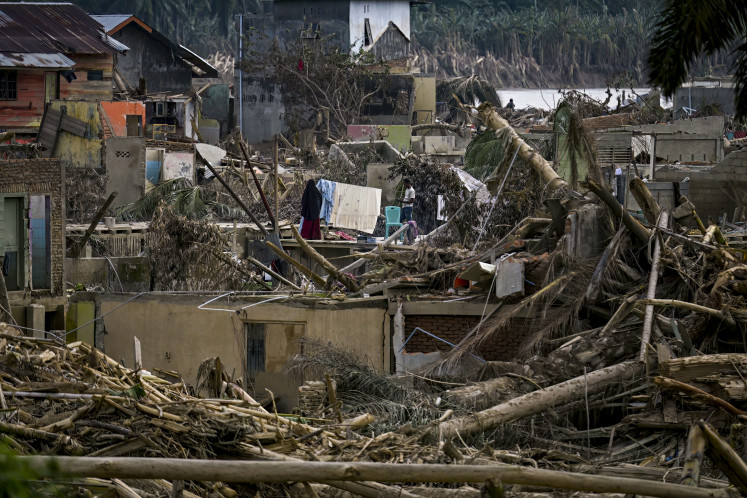Popular Reads
Top Results
Can't find what you're looking for?
View all search resultsPopular Reads
Top Results
Can't find what you're looking for?
View all search resultsWeave through traffic, cars and'¦fish with Google Street View Indonesia
Space age: Go see the futuristic apartment complex on Jl
Change text size
Gift Premium Articles
to Anyone
Space age: Go see the futuristic apartment complex on Jl. Pantai Mutiara at the very tip of North Jakarta.
What if you could check out glitzy steel and glass skyscrapers on Jl. Sudirman with one click and with another, gaze at gliding manta rays in the deep blue waters of Komodo Island National Park?
Google Maps now allows you to do just that following the Indonesian debut of Google Street View, the map's panoramic feature that allows you to view 360 degree photos of streets.
'Mapping started in November 2012, so it has been almost 20 months,' Google Southeast Asia product manager Andrew McGlinchey said regarding when the Google Street View cars first hit the roads with special cameras perched on their roofs.
So far, the Street View feature is available for roads in the key cities of Jakarta, Surabaya, Denpasar and Bogor.
Users can drag the yellow 'pegman' from its box in the right corner of Google Maps to above any street in those cities.
Blue lines will appear on roads whose images have been captured and users can then drop the pegman along these lines to glimpse at the buildings and bridges lining these roads.
Users can even see minibuses, motorcycles and cars snared in traffic as well, in addition to pedestrians like jaywalkers crossing the five-lanes of Jl. Sudirman.
McGlinchey added that given the size of the archipelago, there is 'more to go'.
'This is just our first launch,' he said, further pointing out that this version included a special collection of imagery of the underwater Komodo Island National Park.
The National Park, a UNESCO World Heritage site, is nestled between the islands of Sumbawa and Flores. The park boasts remarkable land fauna, notably the komodo dragon, but also breathtaking marine wildlife that has made the park famous among drivers.
'That was done with the help of the independent organization, Catlin Seaview Survey,' he noted.
The Catlin Seaview Survey scientifically records coral reefs worldwide to showcase them for all to see in high resolution, 360 degree panoramic views.
'They used special underwater cameras, which they have arranged with the national park, and it is our [Google's] job to publish these images so people could see the marine life and coral reefs,' McGlinchey said.
Street View users wanting to take a virtual dive in the park's water from behind their screens can type in 'Komodo Island ' Catlin Seaview Survey' in the search box of Google Maps. They will then find themselves transported in the deep blue, where schools of manta rays graze above an expanse of multi-colored corals.
Tilting the image downwards will enable users to gaze at the entire seabed while tilting the image upwards will allow users to drink in the spectacular view of the manta's underbelly and sunlight aglow in the waters.
McGlinchey added that like any other tropical country, the challenge of capturing images in Indonesia was the heat and humidity.
He added that the computers loaded in the Street View cars had to remain cool. The car operators, thus, had to turn the air-conditioning on high to prevent the overheating of equipment, he pointed out.
Google Street View is already available in 57 countries, including Brazil, Singapore and Ireland.
The service also allows users to look back at images from an earlier time by clicking on the clock icon below the box containing the street's name. However, this feature is limited to certain streets only and times only.
For example, users can utilize this feature on the Hotel Indonesia roundabout, but can only see past images limited to 2013 when Google started to take the images.
And when it comes to handling notorious jams, McGlinchey pointed out that the car operators had to traverse roads when they were least jammed.
'The drivers have to organize and plan a route,' he said. 'When a road is jammed, they will shift to one that is not jammed. They will the return to the previous roads once it is clear.'
McGlinchey added that although Google automatically blurred faces and license plates, users who find objectionable content can file a report to Google. 'There a 'Laporkan Masalah' [report problem] link on the page which people can click on if they want something shot to be blurred and removed.'
He added that Google would work on optimizing the data size of Street View considering that mobile phones were the main access points to the Internet in Indonesia.
'We hope to continue improving things to address countries like Indonesia,' he said.
Visit google.co.id/maps for more information.











